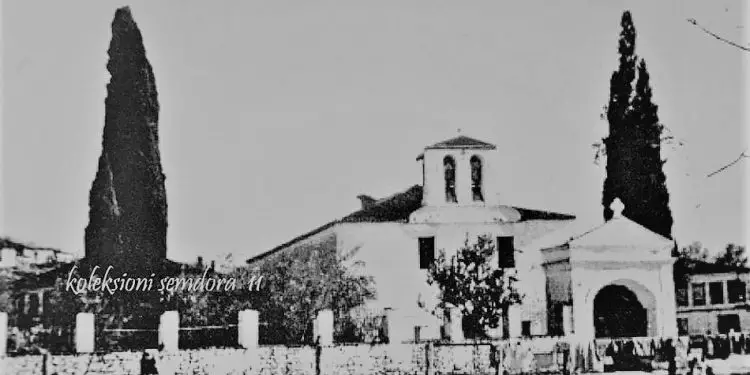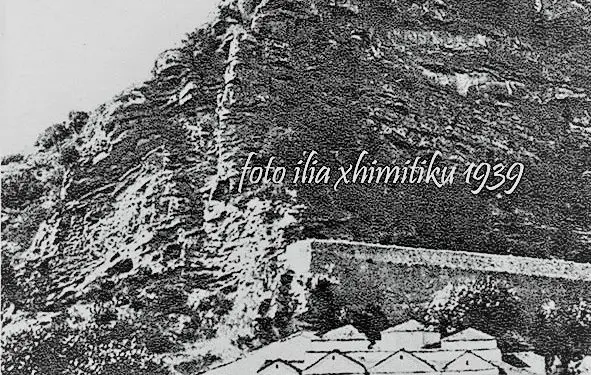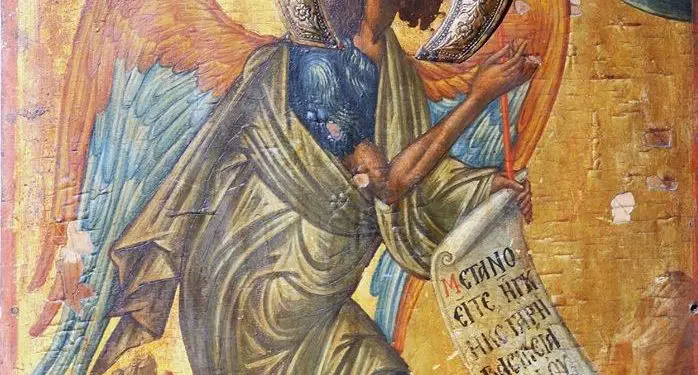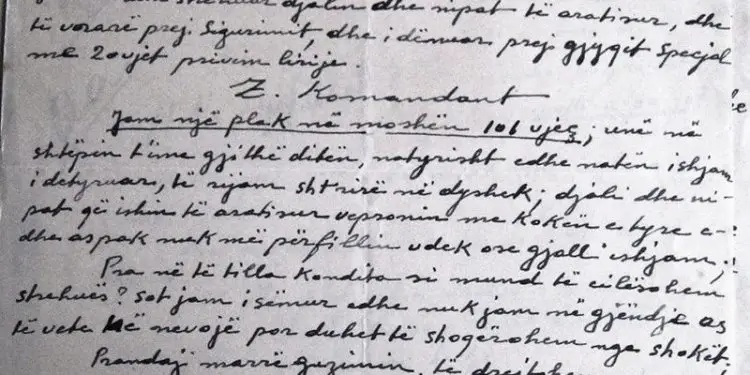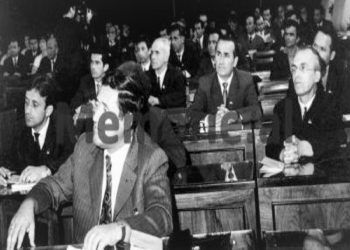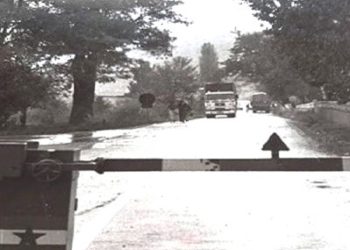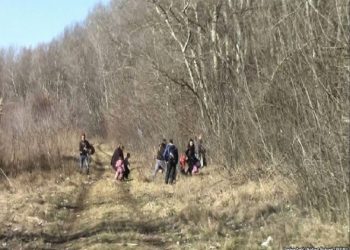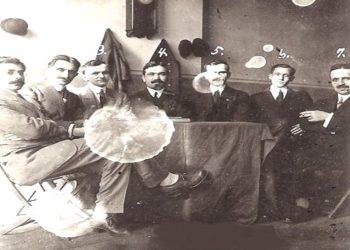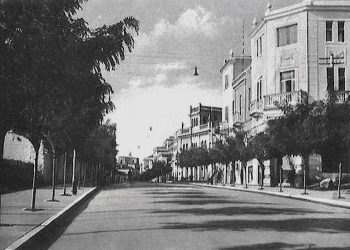By Kastriot Dervishi
Memorie.al / The data and facts about the objects of the Christian cult are numerous, both for the values they have and for the bad luck of many of them until their final disappearance. In January 1967, the youth of the secondary school “Naim Frashëri”, in Durrës, publicly announced the initiative: “To fight to the end religious ideology, superstitions and pagan customs” and on February 6, 1967, Albania was declared “the first state atheist in the world”. And after this regressive movement, a large part of the cult objects were finally destroyed, some of them were repurposed, turning into warehouses. We remember the church of Šendëlli, which was transformed into a stable for army horses. The resistance of the believers has been very small, if not impossible, since the dictatorship state violently suppressed everything against it. There have been sporadic cases. It is worth mentioning a fact from the archives of the time.
In a report on the anti-faith movement, it is written: “Besides the slogans, the reactionary element and clergy have put pressure directly on the people of the Party. In Vokopole, Berat, before the church was taken, an anonymous leaflet was placed, which read: The destruction of the church in Vokopole, has shocked the whole village, big and small. Whoever tears this sheet of lightning will answer.”
But it was impossible to protect them. And bad luck met all the cult objects, but some such as: Church of Saint Kolli, Sinj, Church of Saint Constantine and Helena in Kondas, Church of Saint Thanas, Vërtop, Church of the Dormition of Saint Mary, Mbreshtan, Cathedral of Saint Dhimitri, Berat, Church of Saint Sotir, Konezbaltë, Saint Peter and Saint Pavli, in Poshnje were finally destroyed.
Thanks to the researchers and the preservation of some of the cult objects and icons by the Institute of Cultural Monuments, we can recall the values that they preserved.
Church of Saint Sinjë
The village of Sinjë is known as one of the earliest villages with an Orthodox population in the Berat region, given that it also has the Hermit Church of Saint Mary, the Church of Saint Kolli and the Church of Saint Friday, of which no trace remains. .
The Church of Saint Kolli was built in the XVII-XVIII centuries. It was a large church with iconostasis and frescoes. It had a portico at the entrance and a very beautiful belfry. It was built where the cemetery is today, on the Sinja tap. It was broken among the first in the communist movement, against religion in 1967 by a group of young people. In the main exhibit of the “Onufri” museum, the icon of Johan Pagëzori, with an anonymous author, made in the century is exhibited. XVII-XVIII
Icons from the Church of Saint Kolli are preserved in the Fund of Cultural Monuments of Berat, one of them is the icon “Saint Mitri on a horse”, taken from the iconostasis, which was part of the small icons. The author is anonymous, but we also find him in the Church of Saint Kolli, (Sadovice), in the Resurrection of Christ icon.
Church of Saint Constantine and Helena in Kondas, 1791
This church was on the outskirts of the city of Berat, and was finally demolished in 1967. Icons and parts of the iconostasis of this church are preserved in the fund of Cultural Monuments of Berat. In the apse of the church, the year 1791 was engraved, a date which should indicate construction or reconstruction. In this church, icons made by Tërpo Zografi and Naum Çetiri were found.
In their inscriptions it is written: “By the hand of Tërpo son of Konstantin Zografi, year 1792, September 9. Inscription found on the icon of Saint Constantine and Helena” and: “1823, in April, this icon was painted at the expense of Stavro Mezëlić and to his son Konstantin with the hand of Naum Çetiri”, the inscription on the icon of Saint Mary.
Church of Saint Thanas Vërtop, 1806
In the village of Vërtop, there was the Church of Saint Thanas, which was completely destroyed in 1970. We have information about this church from Theofan Popa, in the church inscriptions. “This temple was painted during the time of the all-gracious Metropolitan of Berat, Mr. Joasaf, from the city of Bubullimani, by the hand of Nikola e Gjergji, from the city of Grabovë. In 1806 and ended on January 15”.
In the inscription are also the names of the vicar, guardian and leaders of the church. The inscription was on the southern gate of the Church. The mural painting of the church was by Nikollë Gjergj Çetiri, made in 1806, this year Johani Çetiri and his son, Nauni, painted in the churches of Kozare village.
Saint Mary’s Church, Mangalem, 1808
Saint Mary’s Church in the Mangalem neighborhood was a large church on the side of the Osum River, near the Gorica Bridge. Today there is only a small room from the ruins of the old church, as well as the defensive wall from the side of the castle rock. The church had the nave, the altar and ancillary facilities from the west, the courtyard with ancillary facilities and the bell tower from the east.
Piere Batiffol and Gjergj Haxhi Mihali wrote about this church. “In the surroundings of the Mangalem neighborhood,” Batiffol wrote, “at the entrance to the Old Bridge over the Beratinos River, I was shown a recently restored church that had a ‘vocable’ of the ‘Dormition de la Vierge’ (the sleeping place of the Virgin ) and which had, as I was told with certainty, a gospel of the IV century. I went down there somewhat excitedly and found a gospel eight centuries later than that date, (XII)”.
About this church, Gjergj Haxhi Mihali wrote in 1927, where, among other things, it is said: “Under the church of Saint Mill, there is the church of Saint Mary of Shumbulli, above the main road on the side of the river, it was probably a small church and more before yes, according to the mouthpiece of the elders, after the Turkish occupation, the church of St. Mary, Murat Çelepijasi was transferred to this place, in 1800, it was burned down, it was erected again as it is today, with beautiful paintings in 1808 “.
The church was covered with a roof which had three drums and four pediments, in the front part above the closed vestibule. The construction of the roof, which had many similarities in construction with that of the Castle Cathedral, allows us to describe the interior of the architectural construction of the nave, the same as the cathedral, starting from the same time of construction within a decade of the Castle Cathedral and of Saint Mary of Mangalem and we can see them in the photos of berata masters Ilia Xhimitiku and Naum Vruho, made for postcards in the 1940s.
The bell tower has been detached from the Church. Between the bell tower and the church, there was the church yard with the auxiliary premises. The bell tower was built using the clapboard technique. With four pediments on all four sides, decorated with two rows of bricks each and with a dome above. The bell tower of the Castle Cathedral has similarities with it, but it was of more architectural value. The church burned down during the Second World War, but was eventually demolished with the widening of the main road.
Saint Mary’s Church, Mangalem has been the most sought after by artists of the 19th century and the first half of the 20th century. Built in a very picturesque place, which included the most beautiful part of the city, such as: Castle, Mangalem, Gorica Bridge, Çelepias neighborhood, the river and its architecture itself.
Edward Lear painted her in three works in 1848. Hungarian foreign photographers in 1918, Austrian Hugo Adolf Bernacik in 1929. Her photos can be found in the Luçe and Vera collections in Italy as well as the Albanian photographers Ymer Bali, 1927 and Irfan Ago, 1935, as well as by Berata photographers Ilia Xhimitiku and Naun Vruho, have been a source of inspiration several times in the 30s.
Saint Mary’s Dormition Church, Mbreshtan, 1815
There is a lot of information about this church in Theofan Popa’s inscriptions, which he took to the church before it was demolished in 1967. The Mbreshtani monastery church has been quite important, since the best builders have worked for it. This is one of the first churches destroyed by the communist regime and in its place, the military department was erected.
The church was built in 1815, a date which was found on the northern gate, where the name of the church guardian, Stefani, was also recorded. On the large icon of the “Sleeping of Saint Mary”, in the iconostasis of the church, it was written: “Prayer of God’s servants Gjergji, Jani, Kostanini, Haxhi Nast, from whom this icon is donated in forgiveness of sins. It was painted by the hand of Christo Itibriani, on February 18, 1826”.
In 1853, the builder, master Nauni, worked on the decoration of the church, the name was engraved on the beautiful door of the iconostasis. On August 10, 1897, the builder, Master Anastas Voskopojari, placed his name on a stone of the belfry, as well as Master Ali Banari, on the northern gate of the church. And from the legends, it is said that Master Jani Ceca built only one dome of the church that had fallen.
The icon of Saint Dhimtri was taken from the Church of Saint Mary in the village of Mbreshtan and is exhibited in the “Onufri” museum. Icons from this church are also found in the Berat Cultural Monuments Fund.
St. Demetrius appears on a red horse in combat clothing at the final moment of the match, during which he accompanied Nestor in a duel with spears against a gladiator who was killing Christians. His knightly figure is presented in the final moment of the act, when he thrusts his spear at the opponent lying horizontally, at the end of the stage, covered with a red cape. The scene takes place in front of a landscape, with a bay in the background and hills behind it.
Church of St. Dimitri, XIX century
In the new center of the city today, near the new cathedral of St. Demetrius, was the Cathedral of St. Demetrius, a basilica with three naves which was built in the middle of the century. XIXth. It was a large main church with many annexes, a bell tower and a steeple, but it was destroyed during the communist period and the dictatorship built the Party Committee on its foundations. In 1922, the Church of Saint Demetrius was declared a cathedral.
Two painters from Fjonati of Greece, Mihali and Kostandini, have painted icons for this church. In the inscriptions of Theofan Popa, it is written: “1861 December 19. By the hand of Mihal and Kostandini fjonatė”. The word Fjonate comes from Fjonati (Hjonadhes) of Greece. The inscription is found on the icon of Saint Mary in the iconostasis of the church. Painter Kostanini from Fjonati can also be found in the Church of St. Miter in the village of Drobonik, in the icon of Kostanini and Elena.
This church had many elements that came from Apollonia, one of them is the bust of a man, c. I-II AD This sculpture, which came from Apollonia, was placed on the wall of the Saint Miter Church, in the center of the city. Phraschniker, describes it in his book and from this book we also have the photo of this sculpture. The bust was about 60 cm. and presents the portrait of a bearded man with his head turned slightly to the right, with disheveled curly hair and a sullen expression on his face.
Saint Sotir Church, 1882
In the village of Konezbaltë, there was the Church of Saint Sotir built in 1882. The year 1882 was engraved on the western gate of the church. Theofan Popa thinks that this date is for the year of the construction or reconstruction of the church. This church was destroyed from the foundations in 1967.
On the hills that surround the city of Berat, there was also the church of Saint Thanas. A small reconstruction has been done by the Lole family. Many churches, such as Saint Marina in Guri e Bardhë, Saint Mary in Konisbalta, Saint E Premtja in Kutalli, Saint Peter and Saint Pavli in Poshnje (which used to be a big church), no longer exist.
There were several other churches in the Shpirag area, but they were eventually destroyed by time, such as the Church of Saint Kolli in Palikesht, (where now there are only its ruins), the Church of Saint Premtes Sinjë, there is no sign. Another church on the top of Mount Shpirag in Penj is Shëndelliu, in Sadovicë was the church of Saint Friday.
Even in the area of Tomorri, there were many churches, but their destruction began very quickly since the time of the Turkish occupation. In Mbrakull, there was the church of Saint Todri, in the village of Tomorr, the church of Saint Mértir. In the village of Malëshove, there were three churches: Saint Mary, Saint Christopher and Saint Thanasi. The Church of Saint Mary had two bell towers, of the basilica type with three naves. Its ruins have reached up to the 1990s. Memorie.al





